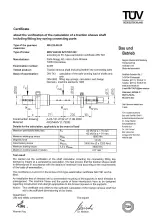
WARNER ELECTRIC EUROPE - Rue Champfleur, B.P. 20095, F - 49182 St Barthélemy d’Anjou Cedex
SM346gb - rev 09/03
4/5
•
Engage the rear disc on the hub as illustrated in Fig. 1,
with the heel on the customer fixing flange side
•
Engage magnet D, repositioning magnet C using the
fixing screws
•
Line the brake up with the customer fixing flange, using
the fixing screws
NOTE:
Secure the fixing screws (safety washer or a
thermoplastic liquid such as Loctite)
•
Tighten the 8 fixing screws CHc M12 (Cs: 111 Nm
±10%) (star sequence tightening, to an initial torque of
50 Nm). The supply of current to the brake should be
switched on throughout this operation
•
Make all the permanent electrical connections
4 Maintenance
4.1
Checking the airgap
Check the airgap at each maintenance inspection.
Reminder:
This brake is intended for a static appli-
cation as a safety brake. Any dynamic braking is
restricted to emergency and test braking. Normal use will
not lead to any noticeable wear on the lining.
Fig. 3
Airgap has to be measured 3 times at the circum-
fence. The maximum value of the three has to be
taken into account.
If the maximum value of the airgap is exceeded on one of
the magnets (see Table 1, page 2), change the 2 discs
and the 2 O-rings.
After the worn friction discs are removed, assembly the
brake according chapter 3.3.
Operation microswitch
Current range 10 mA min. to 100 mA max. at 10 - 24 VDC
Microswitch
connection
When there is no current in the coils (customer’s shaft
braked), the microswitch contacts are in the NC position.
5
Electrical connection
Brakes
ERS VAR09 SZ 1700/1200
WE Number 1 12
106593 and 1 12 106597 and
ERS VAR09 SZ 1700/800
WE Number 1 12 106592 and 1 12 106596 operate on
a direct current supply. Polarity does not affect the way the
brake operates.
5.1
Important recommendations
Make sure that the nominal supply voltage is always
maintained (a lack of power results in a reduced
maximal airgap).
The connecting wires must be thick enough to help prevent
sudden drops in voltage between the source and the brake.
Tolerances on the supply voltage at the brake terminals
+5% / -10% (NF C 79-300).
Airgap
Microswitch
Fig. 4
Ajusting screw for microswitch
Brown
Black
"NC"
Blue
"NO"
4.2
Adjusting the microswitch
Warning:
Be careful to select the microswitch corresponding with the
magnet to be adjusted (see Fig. 4).
Slide a wedge 0,15mm thick close to the screw in the cor-
responding airgap. Switch on the current and tighten the
adjusting screw H M4 (7/flat) in contact with the microswitch
until you reach the commutation point.
Remove the wedge.
Check that it functions correctly by a few successive draws
and releases.






























